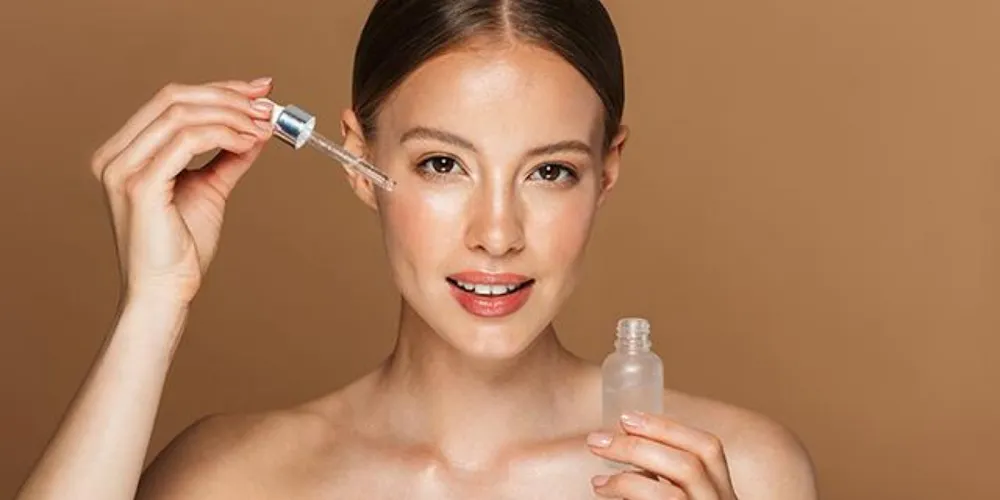Small in size but big on promise, facial serum has become a staple of beauty routines in recent years. You can’t have missed these mysterious bottles in eye-catching colors that have invaded perfumery shelves, Instagram feeds, and the beauty routines of your most skincare-savvy friends. But between you and me, do you know what this often expensive product that may already be sitting in your bathroom is for?

If you’re still hesitant to take the plunge or if you’re already using a serum without being sure you’re getting the most out of it, don’t panic! Today, we’re taking a look at this concentrated treatment that promises the earth. Is serum essential for glowing skin, or just a superfluous product in an industry that’s constantly pushing us to consume more? In this article, we separate the facts from the fiction to discover how these few drops could transform your beauty routine… and your skin!
Face sure, why is everyone talking about it?
We’re not telling you anything new if we tell you that we hear about face serum everywhere. On Instagram, on TikTok, in magazines, at our friends’ houses… These famous little bottles with sometimes intimidating prices seem to have conquered all the bathrooms . But what exactly is behind this product that has become so essential? Is it the magic potion everyone describes it as, or just a well-crafted marketing ploy?
If you’ve ever asked yourself these questions while staring at your bottle (or the one you’re hesitant to buy), you’re not alone! Today, we’re demystifying this star product and explaining why this small size can make a big difference in your beauty routine.
Small but mighty What exactly is a serum?
Let’s start at the beginning: what is a serum? Here’s the short version: a serum is a concentrated treatment that targets specific skin concerns. But if we were to dig deeper, what sets a serum apart from other products is its texture and formulation.
Unlike a moisturizer, a serum has a fine and light texture, often translucent and fluid (even if some can have a gel texture). This lightness is not due to chance! It allows the active ingredients to penetrate more deeply into the epidermis.
And that’s the difference with your other skincare products: a moisturizer acts primarily on the surface to nourish and protect, while an oil forms a nourishing film. A serum, on the other hand, infiltrates deeper layers thanks to its smaller molecules and high concentration of active ingredients (often between 10 and 20 times more concentrated than a cream!). This is why these small bottles can seem expensive even though they contain less product. In the case of a serum, power isn’t measured by volume!
Target, repair, enhance the real role of serum on your skin
Now that you know what a serum is, let’s see what it can do for you. Its main benefit? Acting as a booster for the rest of your beauty routine. Preparing your skin allows your other skincare products to penetrate better and be more effective.
But what makes it strong is its ability to target a specific problem:
-
Worried about fine lines? Retinol or peptide serums will be your allies.
-
Is your skin dehydrated? Hyaluronic acid will come to your rescue.
-
Are you bothered by dark spots? Certain active ingredients, like arbutin or niacinamid, can reduce their appearance.
On the other hand, the serum does not replace your moisturizer (which will seal in all these benefits and protect your skin). Think of it as an intensive treatment that works deep down on your specific skin concerns (lack of hydration, acne, dull complexion, etc.).
Finding the Right Serum for Your Skin
We’d like to warn you: finding the perfect serum takes time and a bit of introspection. The first step is to identify your skin type and your current needs.
Typically, for dry skin choose serums rich in hyaluronic acid or ceramides, which will lock in moisture deep down—and if you don’t know where to look, head here. Conversely, if your skin is oily or prone to blemishes, look for formulas containing salicylic acid, zinc, or niacinamide, which will regulate sebum production without drying it out.
Sensitive or reactive skin , on the other hand, will prefer soothing formulas with active ingredients such as panthenol, allantoin or centella asiatica extracts . As for mature skin or skin concerned about the signs of aging, it will find happiness in serums with peptides, dosed retinol or antioxidants.
But beyond these technical considerations, also listen to your skin’s changing needs! In winter, it may require more hydration. After a stressful period or short nights, a boost of radiance will be welcome. After summer, you may need to address dark spots…
A word of advice: When choosing a serum, don’t be fooled by the marketing hype. The most effective active ingredients should appear in the first third of the list (meaning they’re present in significant quantities). Some star active ingredients to look out for:
-
Hyaluronic acid for hydration
-
Vitamin C for radiance and anti-dark spots
-
Niacinamide to regulate sebum and refine skin texture
-
Retinol or retinaldehydes for anti-aging
-
Peptides for firmness
When and how to apply your serum for maximum effect?
Timing is everything! For your serum to unleash its full superpowers, it must be applied to perfectly cleansed skin, ideally after your toner (if you use one).
The golden rule of applying skincare is to proceed from lightest to thickest. So, after cleansing and toning, it’s time for the serum, then the moisturizer, which will seal in all those beneficial active ingredients.
When it comes to quantity, consider that “less is more. ” Most serums are effective with just 2-3 drops for the entire face. Not only will this help your precious bottle last longer, but it will also prevent the product from remaining on the surface.
Quick application tip: Warm the product slightly between your fingers before applying it with light tapping movements (not rubbing). You can also gently press your warmed palms against your face to help the active ingredients penetrate. Some swear by tools like jade or quartz rollers to maximize absorption, so why not use them from time to time, too?!
Next comes the question of when to apply your serum. How often depends on the serum and your skin, but generally, it’s recommended to apply it both morning and night. It also depends on the active ingredients in your serum: some active ingredients, like vitamin C, are ideal for morning use to protect your skin from the day’s harshest elements, while others, like retinol, are best applied at night to allow skin to regenerate overnight.
Serum or not serum? What you need to know
So, is serum really necessary, or can we do without it? Unfortunately, there’s no right answer to this question, because the truth is: it depends!
If you’re under 25 and have problem-free skin, you can probably stick to a good cleanser and moisturizer suited to your skin type. Serum isn’t a must-have, especially if you’re looking to simplify your routine or save on your beauty budget.
On the other hand, after the age of 30 or when faced with specific skin problems (pronounced dehydration, dull complexion, first wrinkles, recurring imperfections, etc.), the serum a make a difference.
Let’s also not forget that an overly busy beauty routine can sometimes tire the skin or create incompatibilities between products. Sometimes it’s better to stick to the basics and opt for moisturizers enriched with active ingredients or alternate periods with serum during seasonal changes or times when your skin needs a boost.

